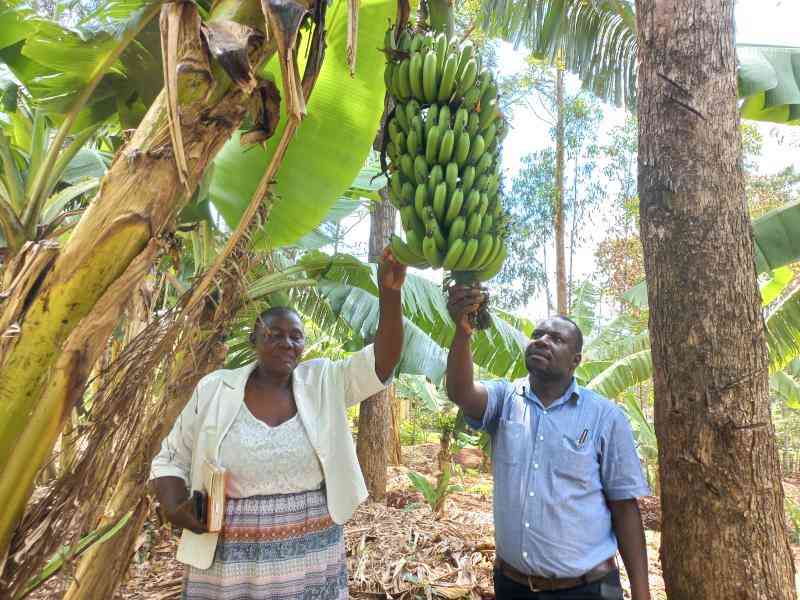
Bananas are one of the oldest fruits known to mankind. In Kenya, bananas are widely consumed, and for that, one may never go wrong with choosing to go the banana way.
To get maximum yield, there are things a farmer needs to consider when planting. Here are a few things to look at.
These steps are as told by Margaret Achieng, a farmer and a businesswoman from Kisumu.
Step one: Choose a variety
In Kenya a wide range of banana varieties is grown which include:
Ripening- Grand naine, Giant Cavendish, Vallery, Williams hybrid, Chinese dwarf, Gold finger, Kisii sweet etc.
Cooking types- Kisii matoke, Uganda Green, N’gombe, Nusu N’gombe, Solio, Ishighame.
Dual purpose – Muraru, Fhia.
If you are planning for the export market, consider the Giant Cavendish. Grand Naine is gaining popularity due to its ability to withstand biological stress.
Step two: Soil preparation
The soil should be well nourished to feed your plant. It is important to provide at least 12 hours of sunlight to encourage growth.
The soil should not be too acidic or too alkaline and it should be rich in organic matter with high nitrogen.
Phosphorus and potash are good for bananas.
Step three: Ecological conditions
Stay informed. Subscribe to our newsletter
Bananas do well in warm and rainy climate because it is a tropical crop. Preferred temperatures are between 10 to 40 degrees celcius.
Strong dry winds cause significant decline in plant growth and fruit production quality.
Step four: propagation
Bananas are propagated by suckers and sword suckers with narrow leaves, this is because bananas do not produce viable seeds.
There is tissue culture, where banana is basically propagated vegetatively. The technique provides robust means to prepare disease-free planting materials that can provide the first line of defense for the banana.
Step five: Planting
Can be grown pit or furrow methods. This can be done at any time of the year. Advantages of tissue cultured planting materials are: plants are free from pests and diseases, there is uniform growth and increase in production, the crops mature early and it is possible to plant all year round.
Step six: Bunch weight and quality
At a spacing of 1.8 meters by 1.8 meters, place two plants per hole to double the yield. Double planting for some varieties such as Robusta could also increase yields.

Step seven: nutrition
Nitrogen and potassium are key elements in growth.
“Remember to use appropriately to avoid weakening the pseudostem and risking damage and deficiency of other nutrients,” said Achieng.
Step eight: Bunch covering
Covering the bunches with a cloth or polythene protects it from the sun, wind and dust, and increases yield. Covering the bunch increases the weight and quality of the fruit. Covering a bunch of bananas raises the temperature, which helps in early maturation.
Step nine: Flower falling off
After the first opening, flowers keep coming, however they are normally sterile. These usually fall off because they do not have the necessary parts to produce fruit even after pollination.
Step 10: Irrigation
Bananas love water, for maximum productivity water regularly, however the roots have poor water retention. Use of drip irrigation and mulching can help improve water use efficiency.
Step 11: Increasing the banana sizes
For maximum yields, frequently fertilise the plants from four to six times during the season. Poor availability of any micronutrients will limit plant growth – especially in leafy areas – and reduce the weight and yield of banana bunches.
 The Standard Group Plc is a
multi-media organization with investments in media platforms spanning newspaper
print operations, television, radio broadcasting, digital and online services. The
Standard Group is recognized as a leading multi-media house in Kenya with a key
influence in matters of national and international interest.
The Standard Group Plc is a
multi-media organization with investments in media platforms spanning newspaper
print operations, television, radio broadcasting, digital and online services. The
Standard Group is recognized as a leading multi-media house in Kenya with a key
influence in matters of national and international interest.
 The Standard Group Plc is a
multi-media organization with investments in media platforms spanning newspaper
print operations, television, radio broadcasting, digital and online services. The
Standard Group is recognized as a leading multi-media house in Kenya with a key
influence in matters of national and international interest.
The Standard Group Plc is a
multi-media organization with investments in media platforms spanning newspaper
print operations, television, radio broadcasting, digital and online services. The
Standard Group is recognized as a leading multi-media house in Kenya with a key
influence in matters of national and international interest.








